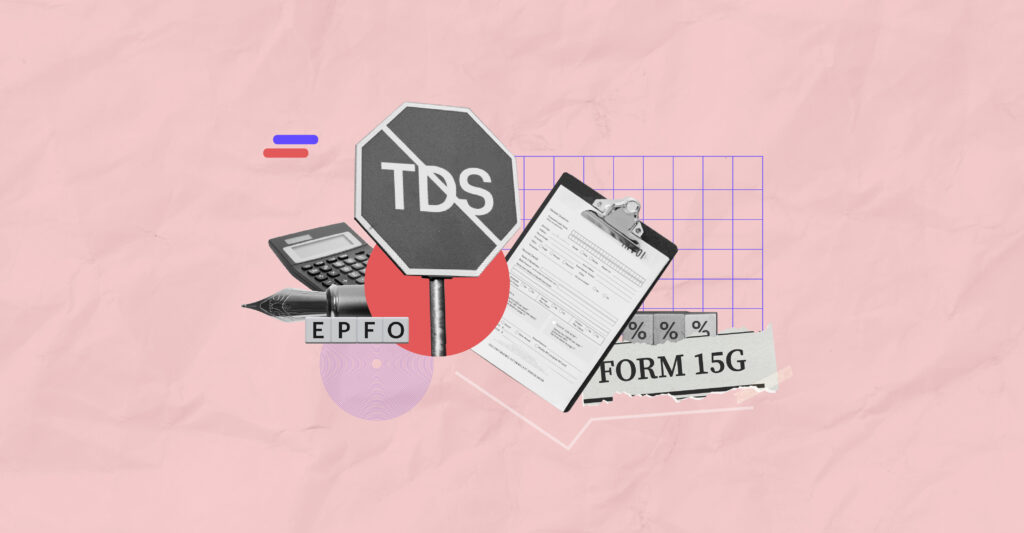Last Updated on Jul 28, 2022 by Anjali Chourasiya
When you are earning less than Rs. 2.5 lakh, you are exempted from the income tax. However, if you don’t submit Form 15G, your bank might apply Tax Deduction at Source (TDS) to your interest amount, or if your EPF withdrawal is more than Rs. 50,000, you might end up paying TDS on it. Form 15G is a declaration to ensure no TDS is deducted from your account if you meet certain conditions. Let’s explore what they are, how to submit Form 15G and the difference between Form 15G and Form 15H.
Table of Contents
Eligibility criteria and where to get Form 15G?
Form 15G can easily be found and downloaded for free from the official EPFO portal and all major Indian banks’ websites. It is also available on the Income Tax Department website. However, you can only use the form when you meet the below-mentioned criteria:
- You are a resident individual of India or a Hindu-Undivided Family (HUF).
- Your computed tax amount in a financial year is nil.
- Your age is less than 60 yrs.
- The total interest you have accumulated on your deposits is less than the basic exemption limit, i.e., Rs. 2.5 lakh.
Difference between Form 15G and 15H
Form 15G is often confused with Form 15H. The latter has a similar objective. However, it applies to senior citizen taxpayers. Let’s look at the difference between them.
| Form 15G | Form 15H |
| You must be below 60 yrs to use this form. | You must be aged 60 yrs or above to use this form. |
| HUFs can also use this form. | HUFs are not eligible to use this form. |
| The total interest income should not exceed the threshold limit of Rs. 2.5 lakh. | There is no such condition for this form. |
| The interest income must be more than Rs. 40,000. | The interest income must be more than Rs. 50,000. |
When should you submit Form 15G or Form 15H?
Form 15G and Form 15H are valid once every financial year. Ideally, you should submit the forms at the start of the financial year. So, your bank does not deduct any tax on your interest income. Make sure you tick all the eligibility criteria before submitting the form.
What to do when you forget to submit Form 15G or Form 15H?
In case you forget to submit Form 15G or Form 15H, there will be no penalty imposed on you. However, the bank might deduct the tax from your account. There are two things you can do in this situation:
- Submit the form immediately – Most banks deduct TDS every quarter. Therefore, submitting the form as early as possible can save the TDS deduction for the remaining quarters.
- File income tax returns – If your bank has deducted TDS from your account, you can claim a refund by filing your income tax return. Banks cannot refund TDS to you as they have already transferred it to the Income Tax Department. Hence, filing an income tax return will help you get a refund.
Where can Form 15G and Form 15H be used?
Apart from saving your interest income if it meets the eligibility criteria, Form 15G and Form 15H can be used in several places, including,
For EPF withdrawals
When you withdraw your Employees’ Provident Fund (EPF) before the completion of 5 yrs, and the withdrawal amount is more than Rs. 50,000, TDS will be deducted. However, if your total annual income is under the threshold limit of Rs. 2.5 lakh, you can submit Form 15G or Form 15H to avoid the TDS deduction.
For income earned from corporate bonds
TDS is deducted from the income you earn from corporate bonds, which is more than Rs. 5,000. In such a situation, if your tax liabilities are nil, you can do so to avoid the deductions and request the issuer of bonds not to deduct TDS.
For insurance proceeds
According to Section 194DA of the Income Tax Act, 1961, the maturity proceeds from a Life Insurance Policy are subjected to TDS if the proceeds are above Rs. 1 lakh and the premium was more than 10% of the sum insured. However, if you are eligible to submit Form 15G or Form 15H, you can submit it to the insurance company to avoid TDS deductions.
For rental income
Your rental income is subjected to TDS if it is above Rs. 8 lakh in a financial year. However, if the income does not exceed the threshold limit of Rs. 2.5 lakh, you can submit Form 15G or Form 15H for non-deduction of TDS.
For post office deposits
Your post office deposits are also subjected to TDS if it exceeds Rs. 40,000 (if your age is below 60 yrs) or Rs. 50,000 (if you are a senior citizen). In this case, if you are eligible for Form 15G or Form 15H, you can submit them to claim TDS exemption.
Form 15G for PF withdrawal – a step-by-step process
Let’s understand how to fill Form 15G for online EPF withdrawal:
Step 1: Log in to EPFO Unified Portal for members.
Step 2: Visit the ‘Online Services’ section.
Step 3: Go to ‘Claim (Form-31, 19, 10C &10D)’ from the drop-down menu.
Step 4: After filling in the required details, you must verify the last four digits of your phone number for the EPF withdrawal form to be visible.
Step 5: Download Form 15G from here.
Step 6: Fill the Form 15G and verify the details.
Step 7: Convert the form into PDF.
Step 8: Complete the process by uploading the PDF format of the form.
Instructions to fill out the Form 15G
Form 15G has two sections. Part one is the one that you fill with the necessary information, whereas part two is the section filled by the person responsible for paying the income.
Components of section one:
- Name of the taxpayer
- PAN card number and status
- The financial year for which declaration is being made
- Residential status
- Address and contact information
- Income details on which TDS is supposed to be deducted with relevant income tax sections
Components of section two:
- Name of the individual responsible for deducting the TDS from the income
- Unique Identification Number (UIN)
- Address of the individual deducting the TDS
- PAN and TAN card number of the individual deducting the TDS
- Contact details
- The date on which the declaration has been received
- The date on which the income has been paid or credited
- The amount of income paid
For the first segment of Form 15G, you need to fill out the following details:
Field (1) Name of the Assessee (Declarant)
Name as mentioned on your PAN Card
Field (2) PAN of the Assessee
You need a valid PAN card. If you don’t have a valid PAN, your declaration will be treated as invalid.
Field (3) Status
Your income tax status. It can be Individual/ HUF/ Association of Persons (AOP), whichever is applicable to you.
Field (4) Previous Year
In this field, you must select the previous year as the financial year for which the declaration is being made.
Field (5) Residential Status
As NRIs are not allowed to submit Form 15G, mention your residential status as a resident individual.
Fields (6-12) Address
Mention your communication address correctly, along with the PIN code.
Fields (13-14) Email id and phone number
After offline communication details, provide a valid contact number and email ID.
Field 15
(a) Whether assessed to tax under the Income-tax Act, 1961: If you have been assessed for Income Tax Act, 1961, for any of the previous assessment years, mark ‘yes’.
(b) If yes, the latest assessment year for which was assessed: If you have marked ‘yes’ to 15 (a), then mention the latest assessment year for which your returns were evaluated.
Field (16) Estimated income for which this declaration is made
For this field, mention the estimated income for which you are making a declaration.
Field (17) Estimated total income of the P.Y. in which income mentioned in column 16 to be included
This field requires you to submit your total estimated income for the financial year. It includes income from all sources.
Field (18) Details of Form No. 15G other than this form filed during the previous year, if any
This field is required if you have filed Form 15G anytime during the financial year. Enter the total number of forms filled and their details with an aggregate amount of income.
Field (19) Details of income for which the declaration is filed
This is the last section of the form. Fill in the details of the investment for which you are filing the declaration. Mention investment account number, nature of the income, section under which tax is deductible, and the amount of income.
After filling in all the details, fill out the declaration and provide your signature. Before submitting, make sure to check all the information once to avoid rejection of the declaration later.
The second section of the form is to be filled out by the deductor, i.e. the person who is going to deposit the TDS to the government on behalf of the taxpayer.
Conclusion
Form 15G is useful to save TDS in many cases. However, it is crucial to remember that providing a false declaration can cause you trouble. Under Section 277 of the Income Tax Act, 1961, you can even face imprisonment. Therefore, always ensure to mention correct details while filling the form for tax-saving purposes.
FAQs
1. What is Form 15G used for?
You can submit Form 15G as a self-declaration that your income is below the taxable threshold limit. So, no TDS should be deducted from the income credited to your account.
2. Who is eligible for Form 15G?
An individual who is a resident individual of India or a Hindu-Undivided Family (HUF), has computed tax amount in a financial year is nil, and their age is less than 60 yrs, is eligible to fill the Form 15G.
3. Can I submit Form 15G online?
Yes, many banks and post offices’ websites allow you to fill and submit Form 15G and Form 15H online.




